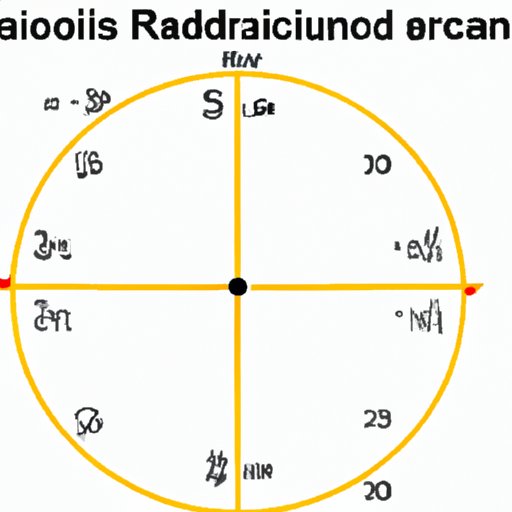
Introduction
Converting radians to degrees can be a frustrating experience for beginners. It’s essential to understand how to convert the two systems of measurement, given how they play important roles in various fields like science and engineering. The purpose of this article is to provide a comprehensive guide for beginners on how to convert radians to degrees.
The Basics: “Everything You Need to Know About Converting Radians to Degrees”
Radians and degrees are the measures that we use to calculate angles in geometry. Radians measure angles as ratios of the length of an arc against the radius of a circle, while degrees measure an angle as a function of 360 degrees on a circle.
The primary difference between the radian and degree measurements is their units of measurement. Radians are expressed in terms of pi (π), while degrees are expressed in degrees (°). Radians are used primarily in mathematical areas such as trigonometry, calculus, and analysis.
For example, in trigonometry, sin(x) and cos(x) are calculated using radians. If the angle being measured is 1 radian, then sin(1) and cos(1) represent the ratio of the length of the sides of the angle.
Quick and Simple Tricks for Converting Radians to Degrees
Converting radians to degrees is a straightforward process that involves the use of a simple formula. To convert radians to degrees, multiply the radians by 180/π. To convert degrees to radians, multiply the degrees by π/180.
There are quick tips and tricks to help you convert radians to degrees. Memorizing the formula for converting radians to degrees can help you in your calculations. Another handy technique is to use estimation to gauge the conversion of radians to degrees.
Step-by-Step Guide: How to Convert Radians to Degrees
Here’s a step-by-step guide to help you convert radians to degrees:
Step 1: Identify the radian measure you want to convert.
Step 2: Multiply the radian measure by 180/π
Step 3: Simplify the resulting product as much as possible.
Let’s say you want to convert 2 radians to degrees. By using the formula above, we can simplify the conversion process:
2 radians × (180/π) = (2 × 180)/π = 360/π degrees, which is approximately equal to 114.592 degrees.
The Importance of Understanding Radians and Degrees in Mathematics
Understanding radians and degrees is crucial in math. Students who are studying higher-level math like trigonometry, calculus, and analysis need to have a solid foundation in radian and degree conversion.
For example, radian-degree conversions are used in the field of calculus, where radians are used to measure the size of angles. Sinusoidal functions, which are used in the calculation of electrical signals and waves, often involves the use of radians. In advanced physics and engineering, radians are used to determine the angle of rotation of an object.
Mastering Radian to Degree Conversion: Tips and Strategies
To master radian to degree conversion, you need to practice as much as possible. One effective way to achieve mastery is by solving practice problems that gradually increase in difficulty.
You can also find helpful resources online that provide practice problems and quizzes that you can solve to improve your fluency.
Common Mistakes to Avoid When Converting Radians to Degrees
While converting radians to degrees is a straightforward process, beginners often make mistakes. The most common mistakes include using the wrong formula or unit of measure.
To avoid these mistakes, always double-check your calculations and make use of online calculators to verify your results.
Real-World Applications of Radian to Degree Conversion in Science and Engineering
The conversion of radians to degrees plays a critical role in various fields such as science and engineering. In physics, radian-degree conversions are used to calculate the rotational displacement of particles, determining the length of medical probes in medicine, and rotating motors and blades in engineering.
Conclusion
In conclusion, converting radians to degrees is an essential mathematical concept that students at all levels should master. In this article, we have provided a comprehensive guide for beginners to help them improve their understanding of radian-to-degree conversion.
By following the tips outlined in this article and practicing your calculations, you’ll be able to convert radians to degrees quickly and accurately.




